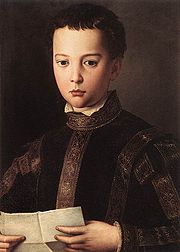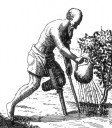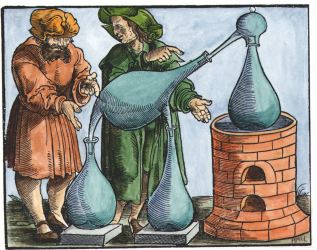| Author | Post |
|---|
Carl Lavoie
Member
| Joined: | Wed Feb 25th, 2009 |
| Location: | Canada |
| Posts: | 215 |
| Status: |
Offline
|
|
Posted: Thu Apr 23rd, 2009 12:33 am |
|
If you follow the web link provided in the fourth (4th) message of this thread, actually, re-pasted here below, you will find the anecdote on the page 57 (out of 154) of the document. Or just type "Archemie" in the site search engine on their toolbar.
http://humanities.uchicago.edu/orgs/montaigne/h/lib/JV1.PDF
I have no clue who that Duc was (does he mean 'Doge'? We also meet them in a few other cities...). Montaigne and his satellites 'arrive' at Florence on the previous page, where one finds the first mention of the Grand Duc, but no name are provided. On page 57, at dinner we find as tablemates of Montaigne the Duc's two brothers, one of which a Cardinal (although, with the rampant nepotism of that age, that dosen't really narrows it down). Anyway, we have Florence, and 1580/1581. That should be fairly easy to find out.
Thank you for verifying the (absence of) references about the ever-burning lights in Pantheo.
As for the 'purification' of the gemstones, when you said : "I believe, for example, that rubies can be 'improved' in this way by injecting them with leaded glass", I thought of :
KUNCKEL von Löwenstern (Johann)
Ars Vitraria Experimentalis, ... (Amsterdam and Dantzig, 1679).
Duveen (p.328) note: " A classic book on glass-making, describing the discovery of ruby glass and the invention of a glass-blowing table with double bellows."
Could that recipe of "ruby glass" have been used by jewellers as 'fillings' for imperfect rubies?
.
|
Paul Ferguson
Member

| Joined: | Fri Feb 15th, 2008 |
| Location: | |
| Posts: | 1538 |
| Status: |
Offline
|
|
Posted: Thu Apr 23rd, 2009 10:32 am |
|
Carl Lavoie wrote:
If you follow the web link provided in the fourth (4th) message of this thread, actually, re-pasted here below, you will find the anecdote on the page 57 (out of 154) of the document. Or just type "Archemie" in the site search engine on their toolbar.
http://humanities.uchicago.edu/orgs/montaigne/h/lib/JV1.PDF
I have no clue who that Duc was (does he mean 'Doge'? We also meet them in a few other cities...). Montaigne and his satellites 'arrive' at Florence on the previous page, where one finds the first mention of the Grand Duc, but no name are provided. On page 57, at dinner we find as tablemates of Montaigne the Duc's two brothers, one of which a Cardinal (although, with the rampant nepotism of that age, that dosen't really narrows it down). Anyway, we have Florence, and 1580/1581. That should be fairly easy to find out.
Thanks.
Some Wikipedia research suggests that the 'Duke' was Francesco I de' Medici (pictured here as a young boy by Bronzino), and that the two brothers were (Cardinal) Ferdinando and either Don Pietro or their half-brother Don Giovanni:
http://en.wikipedia.org/wiki/Francesco_I_de'_Medici,_Grand_Duke_of_Tuscany
http://en.wikipedia.org/wiki/Ferdinando_I_de'_Medici,_Grand_Duke_of_Tuscany
http://en.wikipedia.org/wiki/Don_Pietro_de'_Medici
http://en.wikipedia.org/wiki/Don_Giovanni_de'_Medici
Pietro was in Spain or Portugal in 1580/1, having strangled his allegedly unfaithful wife with a dog-leash fifteen years earlier. Giovanni would have been 17 or 18 at the time of the meeting.Attached Image (viewed 956 times):
 Last edited on Thu Apr 23rd, 2009 12:06 pm by Paul Ferguson
|
Carl Lavoie
Member
| Joined: | Wed Feb 25th, 2009 |
| Location: | Canada |
| Posts: | 215 |
| Status: |
Offline
|
|
Posted: Thu Apr 23rd, 2009 01:07 pm |
|
You are right, Paul, as it states, on the very page : "Nous vismes aussi la palais du Duc, où Cosimo son pere a faict peindre la prise de Sienne...". I missed that.
And below, it says that, indeed, the second brother was only 18 at the time.
I'm sure that Perifano, a contributor of Chrysopoeia, would provide more details...
Perifano, Alfredo.
L'Alchimie a la cour de Come 1er de Medicis: Culture scientifique et systeme politique.
Nature : Doctorat (Nouveau Doctorat). Discipline : Etudes Italiennes. Date : 1990. University : Paris 8. Directeur : Plaisance, Michel. Registration number : 90PA080514.
"Cosimo de Medici (1519-1574) felt a great interest towards alchemy as his contemporaries attest. he devoted himself to an intense activity of distillation and experimentation in his laboratory called "Duke's fonderia". Various manuscripts of alchemy dedicated to the Duke show this interest and favour towards alchemy at the Florence court, as well as the relationship between alchemy, medicine, pharmacology, metallurgy and botany. Even if alchemy was never admitted as an..."
|
Paul Ferguson
Member

| Joined: | Fri Feb 15th, 2008 |
| Location: | |
| Posts: | 1538 |
| Status: |
Offline
|
|
Posted: Thu Apr 23rd, 2009 01:28 pm |
|
Carl Lavoie wrote:
You are right, Paul, as it states, on the very page : "Nous vismes aussi la palais du Duc, où Cosimo son pere a faict peindre la prise de Sienne...". I missed that.
And below, it says that, indeed, the second brother was only 18 at the time.
I'm sure that Perifano, a contributor of Chrysopoeia, would provide more details...
Perifano, Alfredo.
L'Alchimie a la cour de Come 1er de Medicis: Culture scientifique et systeme politique.
Nature : Doctorat (Nouveau Doctorat). Discipline : Etudes Italiennes. Date : 1990. University : Paris 8. Directeur : Plaisance, Michel. Registration number : 90PA080514.
"Cosimo de Medici (1519-1574) felt a great interest towards alchemy as his contemporaries attest. he devoted himself to an intense activity of distillation and experimentation in his laboratory called "Duke's fonderia". Various manuscripts of alchemy dedicated to the Duke show this interest and favour towards alchemy at the Florence court, as well as the relationship between alchemy, medicine, pharmacology, metallurgy and botany. Even if alchemy was never admitted as an..."
Reviewed here:
http://www.persee.fr/web/revues/home/prescript/article/rhs_0151-4105_2002_num_55_3_2161_t1_0439_0000_2
http://www.nuovorinascimento.org/n-rinasc/recensio/rtf/perifano.rtf
Published by Champion:
http://openlibrary.org/b/OL18098806M/alchimie-à-la-cour-de-Côme-Ier-de-Medicis
|
Paul Ferguson
Member

| Joined: | Fri Feb 15th, 2008 |
| Location: | |
| Posts: | 1538 |
| Status: |
Offline
|
|
Posted: Thu Apr 23rd, 2009 03:36 pm |
|
Carl Lavoie wrote:
As for the 'purification' of the gemstones, when you said : "I believe, for example, that rubies can be 'improved' in this way by injecting them with leaded glass", I thought of :
KUNCKEL von Löwenstern (Johann)
Ars Vitraria Experimentalis, ... (Amsterdam and Dantzig, 1679).
Duveen (p.328) note: " A classic book on glass-making, describing the discovery of ruby glass and the invention of a glass-blowing table with double bellows."
Could that recipe of "ruby glass" have been used by jewellers as 'fillings' for imperfect rubies?
.
On Kunckel, allow me to recommend the following article by Hereward Tilton: 'Of Ether and Colloidal Gold: The Making of a Philosophers' Stone'. This is available as a free download from:
http://www.esoteric.msu.edu/VolumeIX/EsotericaIX.pdf
|
Carl Lavoie
Member
| Joined: | Wed Feb 25th, 2009 |
| Location: | Canada |
| Posts: | 215 |
| Status: |
Offline
|
|
Posted: Thu Apr 23rd, 2009 08:22 pm |
|
Very interesting paper, with Kunckel discussed as of p.85 ff. and even the Ever-burning lamps (from p. 95 on). Thanks.
Notice on p. 55 : "Kunrath tells us that he learnt the secrets of the Art by experience and the grace of God [...] and received instruction from a certain learned master of Kabbalah, who was the first to demonstrate to him the procedure [of the transmutation]." He deems it important to mention that his mentor was a Kabbalist.
Last edited on Fri Apr 24th, 2009 03:31 am by Carl Lavoie
|
Carl Lavoie
Member
| Joined: | Wed Feb 25th, 2009 |
| Location: | Canada |
| Posts: | 215 |
| Status: |
Offline
|
|
Posted: Fri Apr 24th, 2009 04:18 am |
|
Two reading notes:
In ‘Alchimie : art, histoire et mythes’ (Textes et Travaux de Chrysopoeia no.1, Paris/Milan, 1995), on pages 534 to 537, the Voarchadumia is discussed regarding its alchemico-kabbalistic terminology.
And in ‘Aspects de la tradition alchimique au XVIIe siècle’ (Textes et Travaux de Chrysopoeia no.4, Paris/Milan, 1998), for the whole, dense page 226, Frank Greiner writes of Pantheo`s views on the cryptic language of the alchemists (`Premier ouvrage alliant alchimie et spéculations kabbalistiques. P.7, son auteur [...] indique les procédés d’occultation dont ils usèrent dans leurs écrits’).
I think that of the several references made about Pantheo, these two are the ones that will be useful.
By the way, just wondering, are you planning an annotated edition, or a translation with a presentation/introduction essay?
|
Paul Ferguson
Member

| Joined: | Fri Feb 15th, 2008 |
| Location: | |
| Posts: | 1538 |
| Status: |
Offline
|
|
Posted: Fri Apr 24th, 2009 09:56 am |
|
Carl Lavoie wrote:
Two reading notes:
In ‘Alchimie : art, histoire et mythes’ (Textes et Travaux de Chrysopoeia no.1, Paris/Milan, 1995), on pages 534 to 537, the Voarchadumia is discussed regarding its alchemico-kabbalistic terminology.
And in ‘Aspects de la tradition alchimique au XVIIe siècle’ (Textes et Travaux de Chrysopoeia no.4, Paris/Milan, 1998), for the whole, dense page 226, Frank Greiner writes of Pantheo`s views on the cryptic language of the alchemists (`Premier ouvrage alliant alchimie et spéculations kabbalistiques. P.7, son auteur [...] indique les procédés d’occultation dont ils usèrent dans leurs écrits’).
I think that of the several references made about Pantheo, these two are the ones that will be useful.
By the way, just wondering, are you planning an annotated edition, or a translation with a presentation/introduction essay?
Thank you for the references.
It will be a translation with an introduction. I hate footnotes, and will try to keep these to a minimum. Adam's aim is to let these old books speak for themselves, so it will just be the unvarnished text in plain English.
I do not know how much I will be able to discover about Panteo's life while I am doing the background research for the translation, but I will try to briefly set the book in its historical context, much as I did for the Bonacina (about to be published).
Thank you once again,
Paul
|
Carl Lavoie
Member
| Joined: | Wed Feb 25th, 2009 |
| Location: | Canada |
| Posts: | 215 |
| Status: |
Offline
|
|
Posted: Sat Apr 25th, 2009 04:30 am |
|
Pantheus decided no longer to profess practicing illicit and duplicitious alchemy, but its very opposite, the art of Voarchadumia, which he presents as a ‘Cabala of Metals’.
Maybe that expression coined by Pantheo (?) was the inspiration for the (pseudo-) Rabbi Siméon ben Cantara's Cabala mineralis.
http://www.levity.com/alchemy/cab_min1.html
|
Carl Lavoie
Member
| Joined: | Wed Feb 25th, 2009 |
| Location: | Canada |
| Posts: | 215 |
| Status: |
Offline
|
|
Posted: Fri Mar 26th, 2010 02:37 pm |
|
.
Hi Paul,
Is Pantheo’s devise on his emblem (his ‘seal’ as Mylius put it) an actual quote, or just a summary of his text(s)?
*****************************************
- J. D. Mylius, Opus medico-chymicum (in Basilica philosophica), Francfort, 1618.
AVGVSTINVS PAN,,
theus Venetus Sacerdos.

Last edited on Fri Mar 26th, 2010 02:43 pm by Carl Lavoie
|
Paul Ferguson
Member

| Joined: | Fri Feb 15th, 2008 |
| Location: | |
| Posts: | 1538 |
| Status: |
Offline
|
|
Posted: Fri Mar 26th, 2010 09:48 pm |
|
Hi Carl,
Well it's certainly not a quote from the Voarchadumia but it might be taken from one of his 'lost works'.
I have not been able to track down the phrase 'Hic est tripater a sale creatus, ab artifice gubernatus et a Vulcano educatus' ('This is the Matter of the Art - created by salt, governed by artifice and extracted by fire') using Google.
I would be very interested in hearing what Adam has to say about the symbolism.
|
Rafal T. Prinke
Member

| Joined: | Tue Mar 4th, 2008 |
| Location: | Poland |
| Posts: | 150 |
| Status: |
Offline
|
|
Posted: Fri Mar 26th, 2010 10:55 pm |
|
Hi Paul and Carl,
I have not been able to track down the phrase 'Hic est tripater a sale creatus, ab artifice gubernatus et a Vulcano educatus' ('This is the Matter of the Art - created by salt, governed by artifice and extracted by fire') using Google.
I find it quoted by de Jong (p. 307) from Maier's Symbola..., who in turn says it is from Lull:
The threefold fatherhood of the "Philosophical Child" or the
"Philosophers' Stone" is also based on Raymundus Lullius Theorica
Testamenti as we can see from Maier's quotation in Symbola Aureae
Mensae p. 372. ". .... Tripater, cuius Lullius meminit in Theorica
testamenti nempe Solis Coelestis, Artificis ingeniosi et Vulcani filius,
a sole creatus, ab artifice gubernatus et a Vulcano educatus".
Best regards,
Rafał
|
Paul Ferguson
Member

| Joined: | Fri Feb 15th, 2008 |
| Location: | |
| Posts: | 1538 |
| Status: |
Offline
|
|
Posted: Wed Oct 13th, 2010 04:57 pm |
|
Carl Lavoie wrote:
The Sieur Gosset, in his book Révélations Cabalistiques (1735) in which he apparently "argued for a cabalistic chemistry" also mention the ever-burning lamps.
While hunting for Greek alchemists in response to Rafał's recent enquiry I came across this article, which I thought was quite interesting:
"FOR more than 1,200 years the ritual of the Holy Fire has been performed in Jerusalem every Easter, with a flame "miraculously" appearing at the darkened tomb of Jesus to symbolise the Resurrection.
...
"But one Armenian torch-bearer, Soukias Tchilingirian, felt the truth had to be told. He said: "It's not a miracle. The Greek priests bring in a lamp - one that has been kept burning for 1,500 years - to produce the Holy Fire."
http://www.telegraph.co.uk/news/worldnews/middleeast/israel/1311064/Mystery-of-Jerusalems-Holy-Fire-comes-to-light.html
|
Carl Lavoie
Member
| Joined: | Wed Feb 25th, 2009 |
| Location: | Canada |
| Posts: | 215 |
| Status: |
Offline
|
|
Posted: Thu Nov 11th, 2010 02:02 pm |
|
.
'Archemy' or rather the word 'Archimastry' appears in Norton' Ordinal in 1477.
Ah, the word Archemie also appear in print in 1591, on the title-page of Ripley’s Twelve Gates :
The compovnd of alchymy, or the ancient hidden Art of Archemie : Conteining the right & perfectest meanes to make the Philosophers Stone, Aurum potabile, [...] Whereunto is adjoyned his Epistle to the King, and others his workes never before published ; with certain briefe additions.

|

Current time is 09:33 am | Page:   1 2 1 2 |
|
|
|

